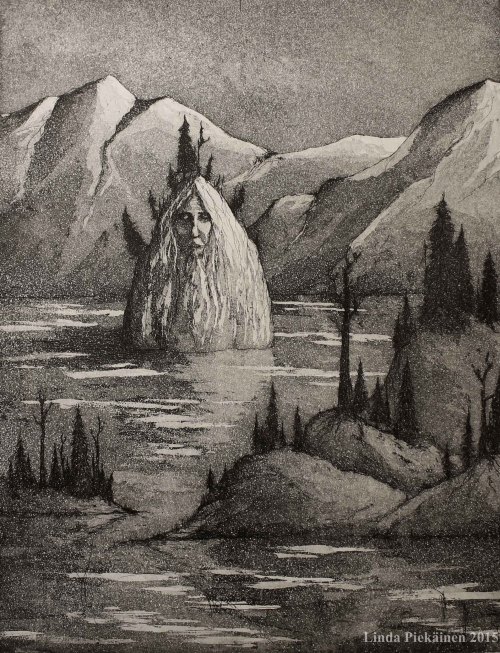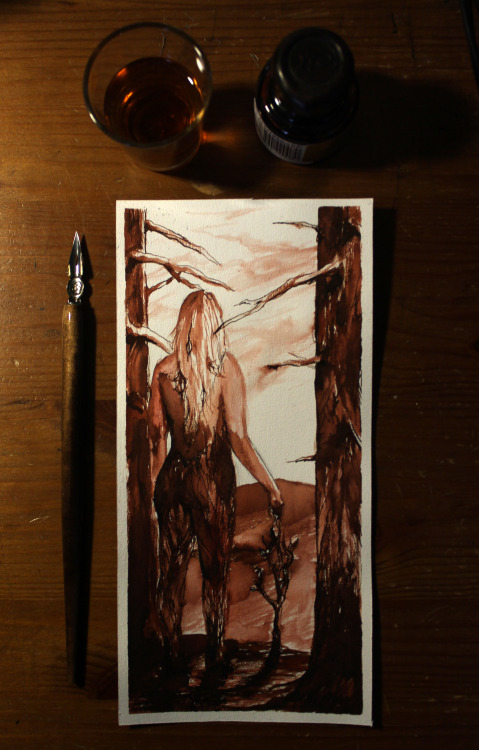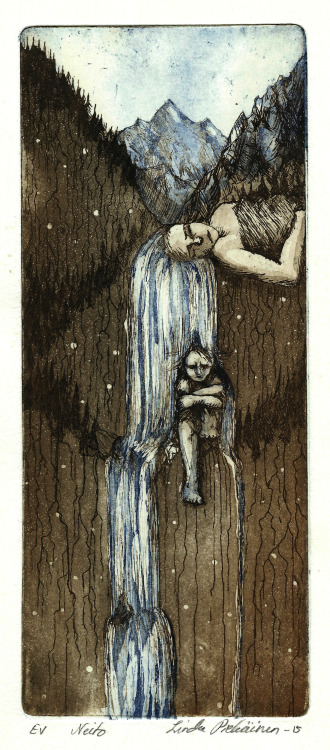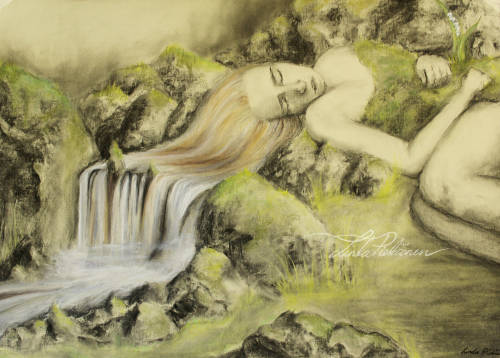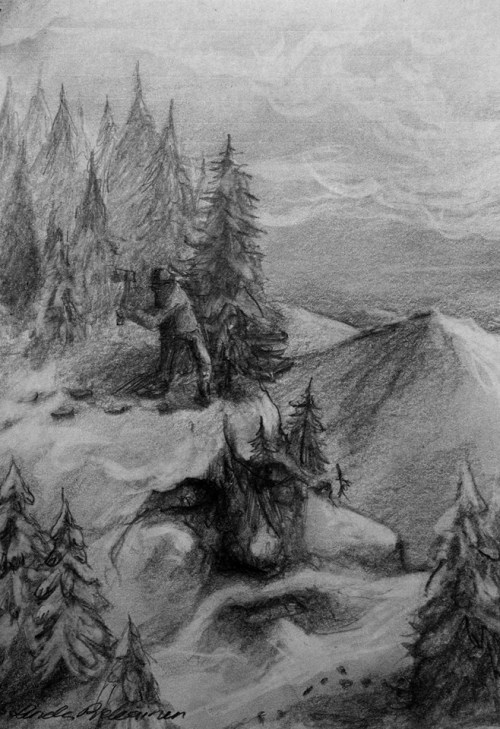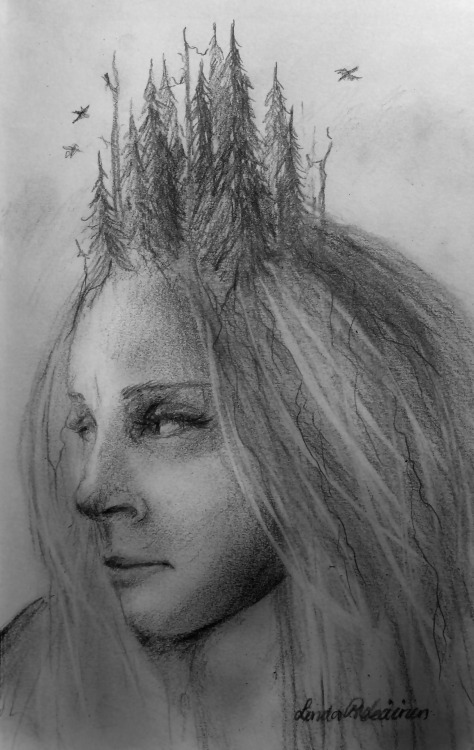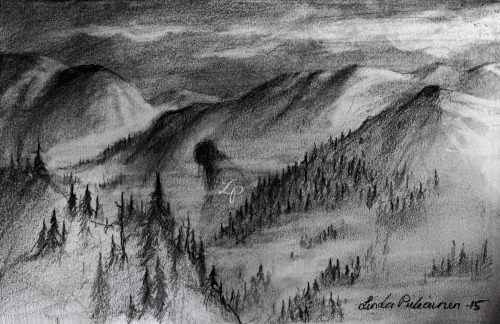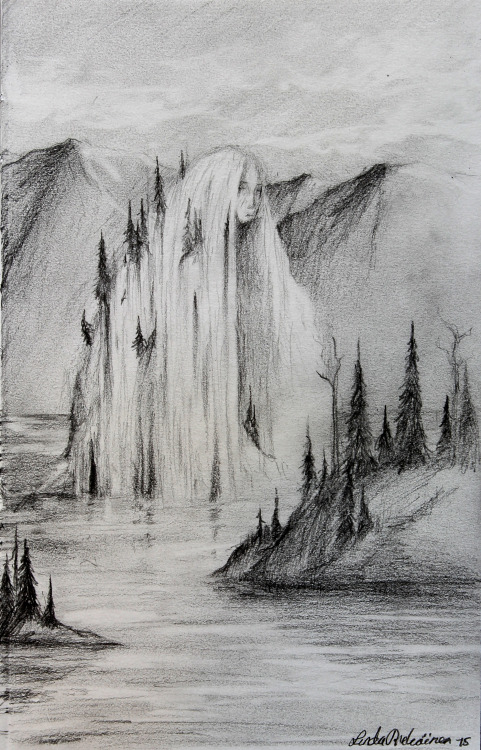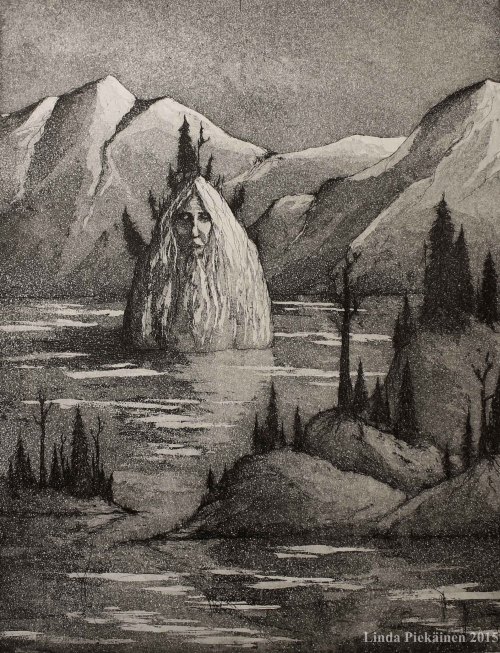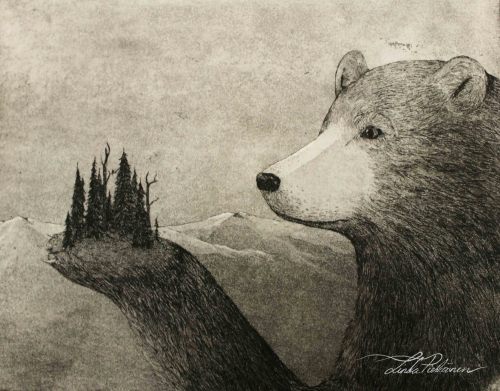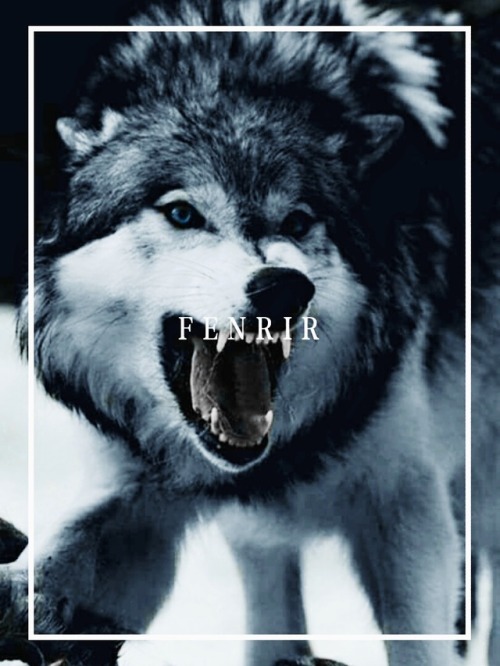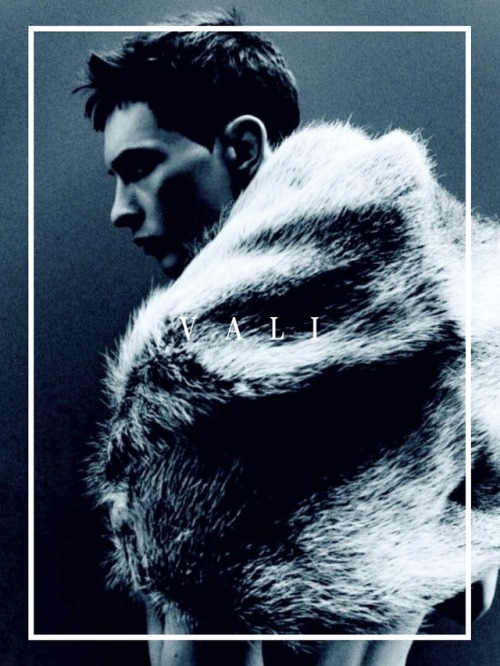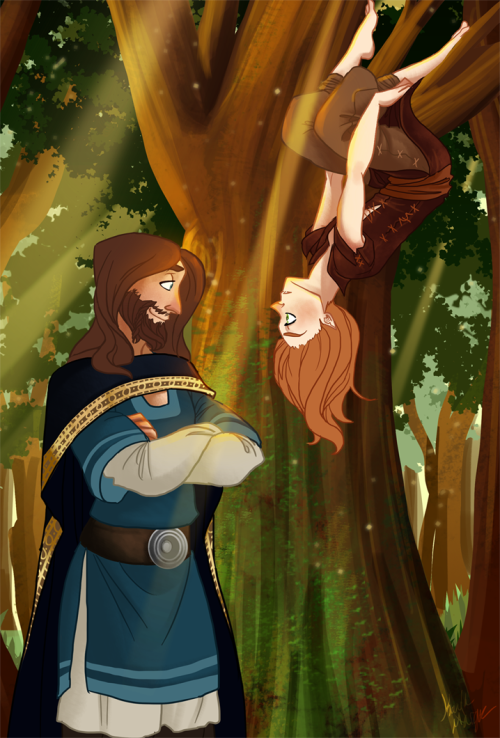#norse myths
They say in the Nordic mythology you need to thank the Forest before you go hunt or cut down a tree. You wouldn’t like to wake up this Jötunn.
Post link
Vellamo, she is the water goddess in the Finnish old mythology. She’s the one who creates the waves in the seas, and brought the good sailing weather.
by Linda Piekäinen (Link on art page Facebook)
Post link
Art about the nature, old tales and mythologies from the North, by a Finnish artist Linda Piekäinen.
Post link
Yggdrasil, the World Tree
By Simon E. Davies of Human Odyssey
In the beginning of the Norse cosmos, there existed an eternal Void, known as Ginnungagap. Out of this nothingness sprang Yggdrasil, a huge Ash tree. Its newly emerging branches held two primordial worlds; Niflheim, a world of ice & frost, and Muspellheim, a realm of molten fire.
When a spring erupted from Nifelheim (known as Hvergelmir), it created a river which crossed the void into Muspellheim. Here, the hot air scorched the freezing river creating a new world, known as Jotunheim, land of the giants.
From this bloodline of primordial beings came Odin, Vili and Ve, who despised the father of giants who ruled his people with malice and brutality. When the chance came, the brothers slew the frost giant, and from his body they created Midgard, a world of mortals. Surrounding this realm they placed a great ocean which nourished the roots of the great tree.
Yggdrasil grew ever higher, forming a new realm called Asgard, which is located on the highest branch of the world tree. This was where Odin, king of the Aesir would take his people to settle a new civilisation. It was said this race of gods brought culture and technology to the world of mortals via a great causeway called Bifrost.
Bifrost was a burning rainbow bridge, connecting Midgard (the world of mortals) with Asgard. This colourful overpass emerged from Himinbjörg, a mountain hall guarded over by the ever-vigilant Heimdall. This watchmen of the gods kept an eye on the mortals below, making sure no giants breached their homeland.
As Yggdrasil continued to grow, a new land emerged on one of its branches called Vanaheim. It was a land full of luscious forests and wild meadows. From this primal wilderness emerged a race of gods known as the Vanir. This tribal people lived near the coast, ruled by Njörðr, a seafaring god who loved wealth and magic, a trait common among his people.
A great tension broke out between the Vanir and the Aesir resulting in a long winded war. It eventually ended in a stalemate, so many of the gods sent their families as hostages to the opposing tribe to help bring them closer together. Njörðr’s son, Freyr, was placed in charge of Alfheim, homeland of the Elves. This class of god-like beings were said to be “more beautiful than the sun.”
These elves were also linked to another realm far below the Earth. Legend says a tribe from Alfheim were exiled from their homeland many eons ago, and eventually sought refuge with the dwarves of the underworld. These subterranean beings had build their homes around the roots of Yggdrasil, carving a network of labyrinths, mines and forges for their empire. They called it Niðavellir, and the elves, who skin eventually became black as night, called it Svartalfar.
All the beings of Yggdrasil, mortals, gods, dwarves and elves would eventually die, and their souls were destined for several realms. If the Aesir died valiantly in battle, they would find rest in Valhalla, for all others, Helheim was their inevitable destination. This dark and gloomy abode resided at the tip of Yggdrasil’s deepest root. This afterlife was ruled over by Loki’s daughter Hel, a strange being who was half black and half flesh-coloured, characterised by a gloomy, downcast appearance.
There are a number of sacred creatures which live within Yggdrasil. this includes the monstrous wyrm Níðhöggr who gnaws at the roots of Nifelheim, weakening the great tree of Yggdrasil. This frost dragon was also known for eating the corpses of the Nifelheim when found guilty of murder, adultery and oath-breaking.
Atop the highest branches of the world tree is perched a great eagle and his hawk companion Vedrfolnir, who sits between his eyes. The two stare deep into the Norse cosmos, perhaps representing insight and awareness.
Ratatosk is a squirrel who runs up and down the world tree to carry messages between the unnamed eagle and Níðhöggr the wyrm. This mischievous critter is said to stir trouble between the all knowing eagle and the world hungry dragon.
Among the branches of the Great Ash tree live four stags known as Dáinn, Dvalinn, Duneyrr and Duraþrór. These ravenous beasts eat the branches of the World Tree, perhaps representing the four seasons. When they eat too much, winter ensues, when they are full, the leaves grow thick and lush in the midst of summer.
Perhaps the most important guardians of Yggdrasil are the three Norns (witches) who lives at the well Urd (below Midgard). Their names are Urd “past”, Verdani “present” and Skuld “future”. These three hags are the goddesses of fate, who spend most their time spinning the threads of life, deciding the fate of every human, animal and god. Every day the Norns will also carry water from Urd’s well, and pour it over Yggdrasil. The water from the well is of vital importance to keep the tree green and healthy.
It is the Norns who foretold Ragnarok, the twilight of the Gods and the fall of Yggdrasil. It is said that Ragnarok will begin when the wolf, Fenrir, son of Loki, breaks free of his imprisonment. This will lead to a chain reaction of events including the Midgard snake Jormungandr rising from the sea and a wolf (known as Skoll) devouring the sun, and his brother Hati, eating the moon, plunging the earth into darkness. The stars will vanish from the sky.
Everything will come to a head in a huge battle that draws in all the races of the nine worlds. It will conclude with Surter, king of the fire giants, setting fire to the great Yggdrasil. The nine worlds will burn, and friends and foes alike will perish, culminating with the earth sinking deep into the abyss of the sea.
Post link
Baldr: Wow you sure have a lot of books on being a god of knowledge
Odin: Well you have to take a course
Odin: Or they won’t let you do it
Thor *texting*: Hey I’m gonna be a half an hour late
Loki *who completely forgot they were hanging out and is still laying in bed*: You always do this
Freya:Yeeted
Thor:Yote
Freya:YEETED
Thor:YOTE
Sigyn: I just want to know who the hell threw Loki out the window?!
Thor: I got arrested for being too cool
Loki: Unfortunately the charges were dropped because there was no supporting evidence
Having seen various incorrect, incomplete and inaccurate lists of Norse gods circulating Tumblr, I have decided to write my own and also include common terminology alongside. I will also include other beings who exist within the old lore and modern traditions.
I have opted to include the names in Norwegian, with translations in parenthesise after, along with a brief summary of some of the associations given to some of those gods. Be aware that, as an overview, brevity is necessary here and the individuals should not be oversimplified to basic aspects in your practice!
Æser (Æsir, Male Gods)
- Balder (Baldr, Baldur) - Light, purity, rebirth
- Brage (Bragi) - Poetry, eloquence, wisdom and music
- Delling (Dellingr) - The new day, dawn
- Forsete (Forseti) - Justice and reconciliation
- Frøy (Freyr) - Vaner, virility, fertility, the sacred religious position of royalty, prosperity, good weather and sunshine
- Heimdall (Heimdallr) - The senses, premonition or foreknowledge
- Hermod (Hermóðr) - Bravery, spirit, possibly a former mortal hero/king elevated to the Æsir
- Hjuke (Hjúki) - Man, lunar activity, lunar phases, moon craters, brother of Bil (the Scandinavian children in the moon)
- Hod(Höðr, Hodr) - The blind god, darkness, rebirth, second chances
- Høne (Hænir, Hœnir) - Survival, sense/spirit, beauty,
- Lodur(Lóðurr) - Blood, warmth, life,
- Loke (Loki) - Change, creativity, ambiguity, impulsiveness
- Lyter (Lýtir) - Premonition, foresight, prediction, prophecy
- Magne (Magni) - Strength, development, son of Tor
- Meile - Son of Odin, brother of Tor
- Mime(Mímir) - Wisdom, knowledge, memory, advice
- Måne (Máni) - The moon, the night sky
- Njord (Njörðr) - Vaner, the sea, harbours, ports, seafaring, wind, fishing, wealth/prosperity, and crop fertility
- Od (Óðr) - Madness, fury, eagerness, excitement
- Odin (Óðinn) - Father, war, battle, victory, death, wisdom, runes, magic, poetry, charms
- Tor (Þórr, Thor) - Thunder, lightning, storms, rain, strength, protection, hallowing, healing, fertility
- Ty (Týr, Tyr) - Law, sacrifice, heroism, glory, war
- Ull (Ullr) - Skiing, archery, hunting, weapons, shields, personal combat, oaths
- Vidar (Víðarr) - Vengeance, atonement, preparation, survival, silence
- Vilje (Vili) - Will, willpower, moderation, the middle, wit, intelligence, touch, sense, motion
- Ve (Vé) - Countenance, appearance, facial expression, speech, hearing, sight
- Våle (Váli) - Revenge, bravery, daring, marksmanship, survival, rebirth
Åsynjer (Ásynjur, Female Gods)
- Bil - Woman, lunar activity, phases of the moon, sister of Hjuke (the Scandinavian children in the moon)
- Eir - Help, healing, protection, mercy, grace, calm
- Fjorgyn/Jord (Fjörgyn/Jörð) - Earth, the world, nature, greenery
- Frigg - Mother, love, fate, prophecy, marriage, birth, midwifery
- Frøya (Freyja) - Vaner, fertility, love, passion, sex, sexuality, beauty, fertility, gold, magic, war, death
- Fulla - domesticity, cleaning, housekeeping, listening, confidant, secrecy
- Gersemi - Precious, beauty, blonde hair
- Gjevjon (Gefjun) - Virginity, plowing, female independence
- Gnå (Gná) - Messenger, errands, crossing planes of existence, travel through land, air and water
- Hnoss - Treasure, beauty, brunette hair
- Idunn (Iðunn) - Youth, vigour, apples, love
- Ilm - Fragrance, aroma, smells
- Irpa - Guardian goddess, Hålogaland
- Lin (Hlín) - Weddings, domestic sphere, flax, onion, fabrics
- Lovn (Lofn) - Benevolence, kindness, gentleness, consolation
- Nanna - Loyalty, empathy
- Njorun - Soil, the land
- Rind (Rindr) - Princess/goddess/giantess, mother of Våle from the East
- Rån (Rán) - Sea, protection from drowning, fishing
- Sigyn - Loyalty, burden, sadness
- Siv (Sif) - Fields, wheat, fertility, family, wedlock
- Sjavn (Sjöfn) - Love, sex, desire
- Snotra - Wisdom, intelligence, cleverness, appropriate conduct
- Sol (Sól) - The sun, warmth, daylight
- Syn - Refusal, denial, speaking out, legal defence
- Såga (Sága) - Seeress, all-seeing, companionship, drinking partner
- Torgerd Hølgebrud (ÞorgerðrHolgabrúðr) - Guardian goddess, Hålogaland, heathen shrines
- Var (Vör) - Honesty, awareness, caution, carefulness
- Vår(Vár) - Oaths (and punishing oath breakers), pledges, agreements, betrothal
Jotner (Jötnar, Elemental Giants)
- Aurvandil - Star, planet, Orion & Big Dipper constellations
- Bauge (Baugi) - Farmer, money, wages
- Dag (Dagr) - Day, light, rides Skinfakse
- Fornjot (Fornjótr) - Ancient giant, ancestor, original, owner
- Frosti (Jökull) - Cold, winter, frost, ice, icicles, glaciers
- Fårbaute (Fárbauti) - Hitting, striking, cruelty, danger, violence
- Geirrød (Geirröd) - Entrapment, cruelty, aggression, violence
- Gyme - Hills, Mounds
- Helblinde (Helblindi) - “Hel Blinder”, “All Blind”
- Hyme (Hymir) - Brewing, cauldron, thick skull
- Kåre (Kári) - Wind, scathe, howl, sails
- Loke (Loki) - Change, creativity, ambiguity, impulsiveness
- Loge (Logi) - Fire, wildfire,
- Mime (Mímir) - Knowledge, wisdom, memory, counsel, Mimes Brønn (Mímisbrunnr)
- Mokkurkalve - Clay, life, innocence, childishness
- Norve (Narfi) - Narrow, oppressive, closed in, difficult birth
- Rungne (Hrungnir) - Strength, brawling, fighting, whetstone
- Snø (Snær) - Snow
- Surt (Surtr) - Fire, heat, burning, blackness
- Suttung (Suttungr) - Mead of poetry, orphaned, eagle
- Tjaste (Þjazi, Thiazi) - Abduction of Idunn
- Torre (Þorri, Thorri) - Black ice, frost, cold, winter
- Trym (Þrymr, Thrymr) - Uproar, King of Jotner,
- Vale (Vali) - Unlucky, wolf, murdered his brother Norve
- Vavtrudne (Vafþrúðnir) - Riddles, weaver of tales
- Utgards-Loke (Útgarða-Loki) - The outer places, magic, illusion, beyond society, an alternate plane
- Yme (Ymir) - The big bang, primordial, birth, the ancestor of all, elemental
- Æge (Ægir) - Sea, ocean, sea creatures, protector of sailors
Gygrer (Gýgr, Elemental Giantess)
- Angerboda (Angrboða) - Grief bringer, sorrow, Iron Wood
- Aurboda ( Aurboða) - Gravel, mountains
- Bestla - Mother to Odin, Vilje and Ve.
- Driva (Drífa) - Snowfall
- Fonn - Snowdrift
- Gerd (Gerðr) - Beauty, light, fertility, earth
- Grid (Gríðr) - Greed, vehemence, violence, impetuosity
- Hel - Death, Helheim (the underworld), Náströnd (“Corpse Shore”)
- Hyrrokkin - Fire smoked, smoke, strength, wolves, serpents
- Jernsaksa (Járnsaxa) - Iron knife, mother to Magne
- Lauvøy (Laufey) - Needle, slender, weak
- Menglød (Menglöð) - Lives in a castle guarded by Fjölsviðr
- Mjoll (Mjöll) - Powdered snow
- Natt (Nótt) - Night, darkness, nightfall, counting time, rides Rimfakse
- Skade (Skaði) - Damage, archery, hunting, skiing, winter, mountains
Vetter (Vættir, Beings) & Other
- Alver (Elves) - Light/Dark/Black, personification of nature
- Andvare (Andvari) - Dwarf, “careful one”, waterfall, fish, wealth, magic ring called Andvaranaut
- Ask og Embla - The first humans, ancestors of humanity
- Diser (Dísir) - Female protective deities/spirits, fate
- Dverger (Dvergar) - Dwarfs, metallurgy, wisdom, smithing, mining, crafting
- Einherjer (Einherjar) - Honoured dead, fallen in battle, sent to Folkvang or Valhalla
- Fenrisulven (Fenrisúlfr) - Death, destruction, rage, the end of times, fen-dweller
- Fjolne (Fjölnir) - Swedish king, Vaner, son of Frøy and Gerd
- Gullveig/Heid (Heiðr) - Volva, seid, enigmatic, “Lust For Gold” or “Golden Drink”
- Kvase (Kvasir) - Wisdom, knowledge, skaldship, poetry, mead, blood, juice
- Midgardsormen (Jörmungandr, Midgard Serpent) - Sea serpent, poison, self-reflexivity, cyclicality
- Norner (Norns) - Weavers of fate, Wyrd, destiny, birth, death
- Sigurd Fåvnesbane - Stag, hero, wisdom, prophecy, speak to birds
- Starkad (Starkaðr) - Jotun, hero, great warrior, many arms cut off by Tor
- Troll - Isolated natural landmarks, strength, slow, dim witted,
- Valkyrjer (Valkyries) - Choosers of the slain, Odin’s maids, spirits, ferocity, death, ravens, wolves
- Vanlande (Vanlandi) - Hero, Swedish king, Vaner, “Man from the land of the Vaner”,
- Vedfinn (Viðfinnr) - Father of Hjuke and Bil
- Vetter (Vættir) - landvette, skogsvette, husvette, vannvette, sjøvette, havvette, hulder, nøkken, draugen, nisse, troll, huldrefolk, deildegasten, dradokke, trollkatt, basilisk, krake, utburd, lyktemenn, varulv, marmæl, lindorm
- Volund (Völundr) - Blacksmith, magical powers, sword maker, hero, alvedrotten (Chieftan of elves)
Well this became popular.
Tusen takk! Many thanks!
I appreciate all of the kind comments and notes.
I went to the Field Museum in Chicago to see their Vikings exhibit yesterday. It was an AMAZING exhibit, but the best part (for me) was seeing my 2007 graphic novel Gods of Asgard being sold in the gift shop, along tons of other cool Viking stuff! I bought a leather belt carved with runes, so… case in point. Special thanks to my distributor NorseAmerica. Find the book at www.godsofasgard.com
Post link
Comics Reader reviewed The Beast of Wolfe’s Bay! They had some good things to say, and compared my artwork favorably with that of the outstanding Fiona Staples. Do I deserve that?Well,I don’t think so. But it’s nice to hear someone say it.
“This was pretty darn brilliant.”
Read the review: http://comicsfancompanion.blogspot.com/2014/11/digitally-speaking22-greg-rucka-loeb.html
Buy the book: http://www.amazon.com/Beast-Wolfes-Bay-Erik-Evensen/dp/0989010406/ref=sr_1_3?s=books&ie=UTF8&qid=1363546588&sr=1-3
Post link
This is completely adorable!
When Odin was still young - before he had hanged himself on Yggdrasil and drunk from the Well of Wisdom - his eyes had fallen on a jotun named Loki.- D’Aularies’ book of Norse Myths
I still don’t know how I feel about this piece…..I don’t feel very satisfied with it :/
I think I’ll have to go back and redo it later…
This is great! ♥ Thanks for sharing!
That’s cute ^^
I love the D'Aulaires’ books, and I love seeing the spark of Odin and Loki’s future bromance.
Post link
My sasquatch book The Beast of Wolfe’s Baygot reviewed at Shelf Abuse this month, and they said the best thing I could have hoped for regarding my female lead, Dr. Winifred Roth: “Winifred Roth is the sort of female character we don’t see enough of in horror or fantasy comics; sensibly proportioned and by no means a mere romantic interest or manic pixie dream girl.”
The rest of the review is good, too, but it makes it seem like the book has no sasquatch in it. It does. 100% sasquatch guaranteed!
You can buyThe Beast of Wolfe’s Bay at Amazon.
Post link

